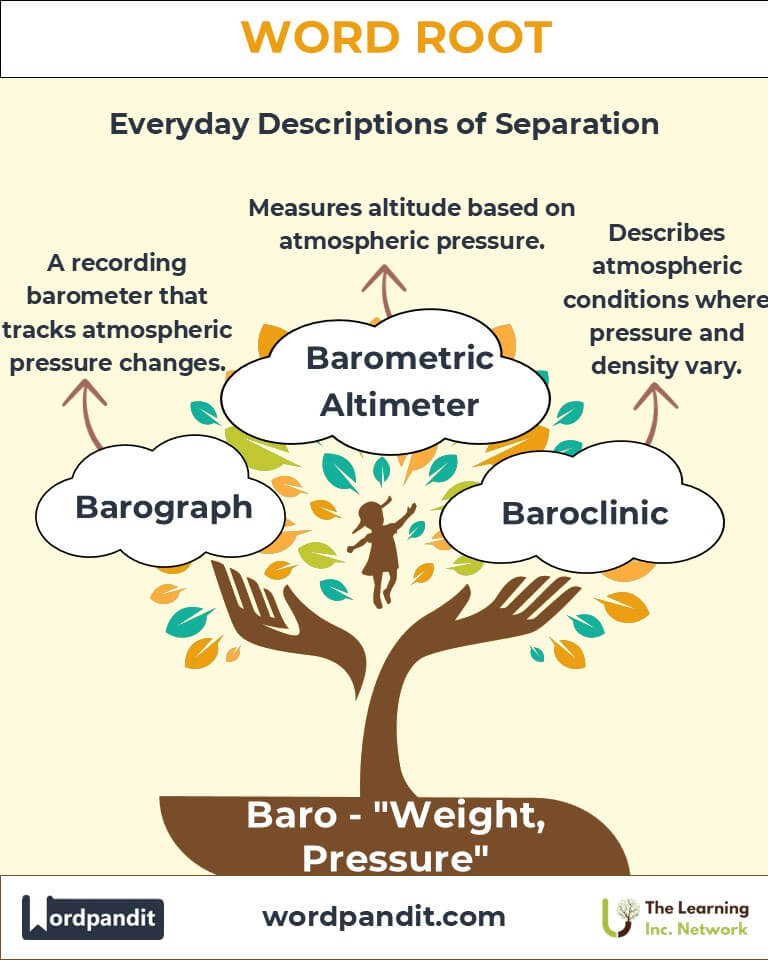Baro: The Measure of Weight and Pressure in Language and Science
Discover the depth and utility of the word root "Baro," derived from the Greek word meaning "weight." From the barometer to baroclinic patterns, "Baro" permeates scientific language, reflecting our need to measure and understand atmospheric pressure and weight's influence on systems.

Table of Contents
- Introduction: The Weighty Essence of Baro
- Etymology and Historical Journey
- Mnemonic: Unlocking the Power of Baro
- Common Baro-Related Terms
- Baro Through Time
- Baro in Specialized Fields
- Illustrative Story: Baro in Action
- Cultural Significance of Baro
- The Baro Family Tree
- FAQs about the Baro Word Root
- Test Your Knowledge: Baro Mastery Quiz
- Conclusion: The Enduring Impact of Baro
Introduction: The Weighty Essence of Baro
What does a barometer measure, and how does the term baroclinic relate to atmospheric phenomena? The root "Baro," pronounced as "bair-oh," comes from the Greek word baros, meaning weight or pressure. Whether used in meteorology or physics, this root underscores humanity’s desire to quantify and understand the invisible forces shaping our environment.
Etymology and Historical Journey
"Baro" originates from the Greek baros, which directly translates to "weight." Ancient Greeks associated baros with the force exerted by a load, eventually evolving into terms describing atmospheric and gravitational forces. With the advent of modern science, "Baro" became foundational in technologies like the barometer, invented in the 17th century by Evangelista Torricelli to measure atmospheric pressure.
Mnemonic: Unlocking the Power of Baro
Picture a scale measuring a heavy object, labeled "Baro," symbolizing weight and pressure.
Mnemonic Device: "Baro bears the weight of the world, from atmospheric pressure to scientific tools!"
Common Baro-Related Terms
- Barometer (bair-uh-met-er): An instrument measuring atmospheric pressure.
- Example: "The barometer dropped, signaling an incoming storm."
- Barometric (bair-oh-met-rik): Relating to atmospheric pressure.
- Example: "Barometric readings guide weather forecasts."
- Barograph (bair-oh-graf): A recording barometer that traces atmospheric pressure changes over time.
- Example: "The barograph's data revealed a consistent drop in pressure during the cyclone."
- Baroclinic (bair-oh-klin-ik): Describes atmospheric conditions where pressure and density vary.
- Example: "Baroclinic instability often leads to severe weather events."
- Isobar (eye-so-bar): A line on a map connecting points of equal atmospheric pressure.
- Example: "Isobars on the weather chart indicated high-pressure zones."
Baro Through Time
- Barometer (17th Century): Revolutionized meteorology by quantifying atmospheric pressure, enabling accurate weather predictions.
- Baroclinic Instability (20th Century): Advanced our understanding of weather dynamics, particularly in storm formation and ocean currents.
Baro in Specialized Fields
- Meteorology:
- Baroclinic Zones: Key in forecasting storms and understanding temperature gradients.
- Impact: Essential for predicting hurricanes and cyclones.
- Aviation:
- Barometric Altimeter: Measures altitude based on atmospheric pressure.
- Application: Guides pilots during takeoff and landing.
- Physics:
- Barotropic Fluids: Simplifies fluid dynamics by assuming density depends only on pressure.
- Relevance: Crucial in thermodynamic studies.
- Geography:
- Isobars: Help map atmospheric pressure differences across regions.
- Significance: Crucial in weather mapping and analysis.
Illustrative Story: Baro in Action
Dr. Sarah, a meteorologist, faced a dilemma: a typhoon threatened the coast, but its trajectory remained unclear. By analyzing barometric data and studying baroclinic patterns, she pinpointed the storm’s path, enabling timely evacuations. Meanwhile, her assistant used a barograph to track pressure changes, refining future forecasting models. Their efforts underscored the power of "Baro" in saving lives and advancing science.
Cultural Significance of Baro
"Baro" reflects humanity's constant quest to measure and comprehend forces shaping our lives. In historical terms, barometers symbolize ingenuity, bridging natural phenomena and technological innovation. Today, terms like baroclinic extend "Baro’s" influence into climate studies, emphasizing its relevance in addressing global challenges.
The Baro Family Tree
- Grav- (Latin, "heavy"):
- Gravity: The force of attraction between objects.
- Gravitas: Seriousness or weight of character.
- Press- (Latin, "to press"):
- Pressure: The force exerted on an area.
- Compress: To reduce in volume by applying force.
- Hydro- (Greek, "water"):
- Hydrobarometer: Measures water pressure.
- Hydraulics: The science of liquid pressure.
FAQs About the Baro Word Root
Q: What does "Baro" mean?
A: "Baro" comes from the Greek word "baros," meaning weight or pressure. It signifies the measurement of physical forces exerted by gravity, atmospheric pressure, or other external conditions affecting weight.
Q: What is a barometer used for?
A: A barometer is a scientific instrument that measures atmospheric pressure. By analyzing these pressure readings, meteorologists can predict weather changes, such as identifying an incoming storm when the pressure drops.
Q: What does baroclinic instability describe?
A: Baroclinic instability refers to a situation in meteorology where pressure and density vary with temperature. These variations often drive large-scale weather phenomena, including the development of cyclones and storm fronts.
Q: How does "Baro" relate to aviation?
A: In aviation, a barometric altimeter is used to measure altitude based on changes in atmospheric pressure. This tool helps pilots determine their height above sea level, especially in low-visibility conditions.
Q: What are isobars, and how are they used?
A: Isobars are lines on a weather map connecting points of equal atmospheric pressure. Meteorologists use them to identify pressure systems, with closely spaced isobars indicating strong winds and widely spaced ones signaling calm weather.
Q: Who invented the barometer?
A: The barometer was invented by Evangelista Torricelli in 1643. His mercury-based device demonstrated that air pressure could be measured, revolutionizing meteorology and scientific studies of the atmosphere.
Q: What is a barograph, and how does it differ from a barometer?
A: A barograph is a recording device that traces atmospheric pressure changes over time, producing a continuous graphical record. Unlike a simple barometer, which provides current readings, a barograph shows trends and patterns useful for weather forecasting.
Q: What is the role of barometric pressure in weather forecasting?
A: Barometric pressure helps predict weather changes. A falling barometer indicates low pressure, often associated with storms and rain, while a rising barometer suggests high pressure and clear skies.
Test Your Knowledge: Baro Mastery Quiz
1. What does the root "Baro" signify?
2. Which instrument measures atmospheric pressure?
3. What do isobars represent?
4. What field uses baroclinic terms extensively?
5. Who invented the barometer?
Conclusion: The Enduring Impact of Baro
The root "Baro" embodies the interplay between weight, pressure, and measurement. From meteorology to physics, its influence extends across disciplines, shaping how we understand and interact with the forces around us. As we continue to explore and innovate, "Baro" reminds us of the importance of precision and inquiry in unraveling the mysteries of our world.











